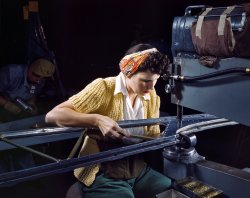
MAY CONTAIN NUTS

Search Shorpy
SHORPY ART

Framed or unframed, desk size to sofa size, printed by us in Arizona and Alabama since 2007. Explore now.
Join and Share
Ad-Free Shorpy
Shorpy is funded by you. Patreon contributors get an ad-free experience.
Learn more.

Recent comments
- Recent view
- Hudson’s Big Store
- Say what??
- Grapes?!
- A Beautiful Moment
- Such joy
- Bethune-Cookman University today...
- Yellow sky at morning
- Side Winder
- Air Quality?
- Sojourner Truth riot
- None were so blind(ed)
- The less famous sister
- Good ol' days?
- Rise and Fall
- Goo Goo Ga Joob
- Ticket Retention
- Not the only one
- Vagaries of War
- Killed by Amtrak
- Back to the Future
- Wanted --
- If you can't stand the light
- Centralized Traffic Control, I believe
- What's really happening
- Heckuva remote control!
- Sometimes — Things Go Bump!
- I SEE THE LIGHT
- Union Switch and Signal Company
- Get That Light Out Of My Eyes
Member Photos
The Shorpy
Print Emporium
Print Emporium
Search Shorpy
Search results -- 30 results per page
- Breaker Boys: 1900
- ... mine after he got married, and lived a long life. Vance Palmer was a trapper, but worked in a glass factory almost his whole adult ... worked in the mines, and died at the age of 60. Puma, Palmer, and Beafore were married and had children. Get your facts straight ... Posted by Dave - 07/24/2012 - 7:15pm -
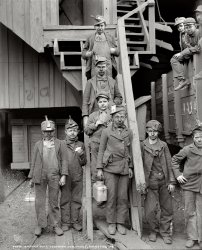
- Metalhead: 1942
- ... View full size. 4x5 Kodachrome transparency by Alfred Palmer for the Office of War Information.
Slice and Dice Those curlicues ... different. - Dave]
(The Gallery, Kodachromes, Alfred Palmer, Aviation, WW2) ... Posted by Dave - 08/30/2012 - 3:31pm -
![Metalhead: 1942 October 1942. "Office employee Annette del Sur publicizing salvage campaign in yard of Douglas Aircraft Company, Long Beach, California. The earrings and hair ornaments are fashioned from aluminum turnings." View full size. 4x5 Kodachrome transparency by Alfred Palmer for the Office of War Information.
Slice and DiceThose curlicues look sharp enough to be dangerous.
Metal shavings are sharp!Hopefully, she had those shavings sanded down a little. When I was young and stupid, I made a copper "ring" with a pipe-cutter and didn't realize the indent it made on the inside of the ring had an edge!
Picture # 2I am sure I saw this same picture published on these pages on an earlier date.
[This is our third photo of Annette so far. But they're all different. - Dave]
(The Gallery, Kodachromes, Alfred Palmer, Aviation, WW2)](https://www.shorpy.com/files/images/1a35349u.thumbnail.jpg)
- Killer B: 1942
- ... plant, Kansas City." 4x5 Kodachrome transparency by Alfred Palmer. View full size.
You give us those nice bright colors ... was the daze...
(The Gallery, Kodachromes, Alfred Palmer, Aviation, WW2) ... Posted by Dave - 07/27/2012 - 12:18pm -
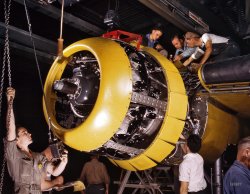
- A Full Tank: 1942
- ... View full size. 4x5 Kodachrome transparency by Alfred Palmer for the Office of War Information.
Tanks Can someone tell me ... but also bolts.
(The Gallery, Kodachromes, Alfred Palmer, WW2) ... Posted by Dave - 08/04/2012 - 11:07pm -
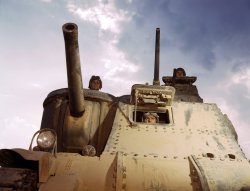
- Balloon Wranglers: 1942
- ... View full size. 4x5 Kodachrome transparency by Alfred Palmer.
Use? How were these things used? Looks like it would be a ... bombs in 1944.
(The Gallery, Kodachromes, Alfred Palmer, Aviation, WW2) ... Posted by Dave - 08/30/2012 - 1:58pm -
![Balloon Wranglers: 1942 May 1942. Another shot of Marines training with barrage balloons at Parris Island, S.C. View full size. 4x5 Kodachrome transparency by Alfred Palmer.
Use?How were these things used? Looks like it would be a sitting duck on the battlefield.
[Hmm. If only there were some easy way to look up the answer. - Dave]
Barrage BalloonsAw come on Dave you know that there are people in your readership who are just as capable as Google in giving an answer.
Barrage balloons were used primarily to protect fixed installations or cities. The idea was to force aircraft - specifically dive bombers - to drop their bombs from higher altitudes thereby reducing accuracy and or to force a low flying plane to change course repeatedly rather than have a straight bombing run. The cables with which a barrage balloon was tethered would be dangerous to planes - they could rip a wing off for example. The British deployed more than 400 barrage balloons over London in 1940 (during the Blitz) and by 1944 there were over 3000 barrage balloons in England. The Balloon Barrage destroyed over 200 V-1 flying bombs in 1944.
(The Gallery, Kodachromes, Alfred Palmer, Aviation, WW2)](https://www.shorpy.com/files/images/1a35100u1_0.thumbnail.jpg)
- Testing, Testing: 1942
- ... View full size. 4x5 Kodachrome transparency by Alfred Palmer.
Always amazing It never ceases to amaze me how beautiful and ... trade as a "megger"
(The Gallery, Kodachromes, Alfred Palmer, Aviation, WW2) ... Posted by Dave - 08/10/2012 - 8:35pm -
![Testing, Testing: 1942 October 1942. "Testing electric wiring at Douglas Aircraft Company. Long Beach, California." View full size. 4x5 Kodachrome transparency by Alfred Palmer.
Always amazingIt never ceases to amaze me how beautiful and detailed these 4X5 Kodachromes are. Every hair, the text on the equipment - it is all there. Great photo!
[Detail below. - Dave]
Testing...Good grief, at first glance I thought she was one of my old schoolteachers.
Insulation testingAmong other things, she's testing the strength of the insulation with that Megohmeter, known in the trade as a "megger"
(The Gallery, Kodachromes, Alfred Palmer, Aviation, WW2)](https://www.shorpy.com/files/images/1a35327u.thumbnail.jpg)
- Angel of History: 1942
- ... View full size. 4x5 Kodachrome transparency by Alfred Palmer.
Cowling I believe the yellow painted parts on the cowling are ... worker's head is.
(The Gallery, Kodachromes, Alfred Palmer, Aviation, WW2) ... Posted by Dave - 08/03/2012 - 3:37pm -
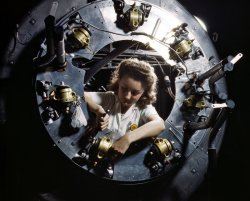
- Long Beach: 1942
- ... View full size. 4x5 Kodachrome transparency by Alfred Palmer for the Office of War Information.
This aircraft While you may be ... feature women.
(The Gallery, Kodachromes, Alfred Palmer, Aviation, WW2) ... Posted by Dave - 08/10/2012 - 4:54pm -
![Long Beach: 1942 October 1942. "American mothers and sisters, like these women at the Douglas Aircraft Company plant in Long Beach, California, give important help in producing dependable planes for their men at the front." View full size. 4x5 Kodachrome transparency by Alfred Palmer for the Office of War Information.
This aircraftWhile you may be right about it being a B-17, I am not certain it is. This cannot be the area where the B-17 wing carries through the fuselage, because it was low-wing and hugely thick. This is most likely the horizontal stabilizer area in the back of the plane. If you look at the original in the top left you can see a structure which is probably the leading edge of the tail fin and above their heads are support structures for the vertical tail. What has me confused are those reinforcement strips below them.
Any idea....why type of airplane they're working on? I've found sources saying Douglas built B-17s at the Long Beach factory. This seems to be one. The section they're working in could be where the wings meet the fuselage.
[The B-17F "Flying Fortress" bomber, A-20 "Havoc" assault bomber and C-47 transport were among the aircraft made at the Long Beach plant. - Dave]
AirplaneCould those strips be part of a cradle underneath the fuselage? Hard to tell because of the shadows, but they look like they may have some sort of padding between them and the plane.
FrumpMother is getting kinda frumpy, but sister is attractive.
Ever Noticed?The Kodachromes with the most comments feature women.
(The Gallery, Kodachromes, Alfred Palmer, Aviation, WW2)](https://www.shorpy.com/files/images/1a35331u.thumbnail.jpg)
- The Finishing Touches: 1942
- ... View full size. Kodachrome transparency by Alfred Palmer.
No OSHA The guy on the ladder at left is standing on the edge of ... final fate.
(The Gallery, Kodachromes, Alfred Palmer, Aviation, WW2) ... Posted by Dave - 08/05/2012 - 9:28am -
![The Finishing Touches: 1942 October 1942. Final assembly for a B-25 bomber at North American Aviation, Inglewood, Calif. View full size. Kodachrome transparency by Alfred Palmer.
No OSHAThe guy on the ladder at left is standing on the edge of the top step!
Oddly enough......this fellow's name was Jim Osha and his unfortunate accident immediately after this picture was taken had far reaching ramifications... :-)
Safety 1stHe actually fell after photo was taken? Do you know what happened next? Was he badly injured or killed from his fall? Were better safety measures taken after the fall? Just curious to know, I work in aviation and have always been instructed on working safely.
[That was a joke. Jim Osha. Get it? - Dave]
B-25 in the backgroundThe B-25 at the right edge of the photo (tail #253332 or 42-53332) had an interesting history. It was transferred to the Netherlands East Indies Air Force as #N5-122 as part of a joint NEIAF and RAAF squadron that operated out of Australia (since the Dutch East Indies had largely fallen to Japan.) That squadron apparently suffered great losses of the B-25Cs, but no word on this plane’s final fate.
(The Gallery, Kodachromes, Alfred Palmer, Aviation, WW2)](https://www.shorpy.com/files/images/1a35296u.thumbnail.jpg)
- The Avenger: 1943
- ... at Vultee-Nashville. 4x5 Kodachrome transparency by Alfred Palmer for the Office of War Information. View full size.
Great pic ... very strenuous.
(The Gallery, Kodachromes, Alfred Palmer, Aviation, WW2) ... Posted by Dave - 01/06/2021 - 11:50am -
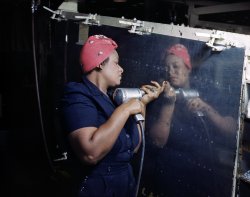
- River of Fire: 1941
- ... View full size. 4x5 Kodachrome transparency by Alfred Palmer for the Office of War Information.
Youngstown, OH A friend just ... the monkey."
(The Gallery, Kodachromes, Alfred Palmer, Industry & Public Works) ... Posted by Dave - 08/30/2012 - 3:29pm -
![River of Fire: 1941 November 1941. "Slag runoff from one of the open-hearth furnaces at Republic Steel in Youngstown, Ohio. Slag is drawn off the furnace just before the molten steel is poured into ladles for ingotting." View full size. 4x5 Kodachrome transparency by Alfred Palmer for the Office of War Information.
Youngstown, OHA friend just introduced me to this blog and I was so excited to see this picture. My grandfather worked at this steel mill. He probably didn't get there until the 50s, but I'm sure it looked the same.
Light of the mills.I grew up on the near north side of Youngstown and during WWII we could read our comic books on my front porch by the light of the furnaces. It was a great place in the 1940s and 50s.
Steel Mill PhotosCan anyone direct me to more Steel Mill photos on Shorpy?
[Use the Search box at the top of the page. - Dave]
Flushing the monkey.Open-hearth furnaces had one tap hole and when tapped everything came out. Steel first then the slag. This a blast furnace. The slag notch on a blast furnace is several feet higher in the hearth than the iron notch which is at the very bottom. The bustle pipe above the workman's head and the tuyere just to the right of where he is standing are the giveaways. Here the slag is being tapped off before it can reach the tuyeres and in anticipation of tapping the iron. Many years ago I knew an ex steel worker who had retired in the late fifties. He told me where he had worked the slag notch was called the monkey and tapping off the slag was "flushing the monkey."
(The Gallery, Kodachromes, Alfred Palmer, Industry & Public Works)](https://www.shorpy.com/files/images/1a35054u_1.thumbnail.jpg)
- Pistons Aplenty: 1942
- ... Cincinnati." Medium format nitrate negative by Alfred Palmer for the OWI. View full size.
Zollner Pistons I see that these ... powered tank used by the Marines.
(The Gallery, Alfred Palmer, Cincinnati Photos, Factories, WW2) ... Posted by Dave - 07/29/2012 - 2:39pm -
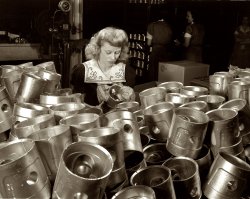
- Flag Day: 1942
- ... View full size. 4x5 Kodachrome transparency by Alfred Palmer.
Hmm, something wrong there.. Someone goofed, there are only 48 ... (I'm from Italy...)
(The Gallery, Kodachromes, Alfred Palmer, Patriotic, WW2) ... Posted by Dave - 08/30/2012 - 12:00pm -
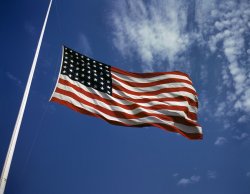
- Student Driver: 1942
- ... Kentucky." 4x5 inch Kodachrome transparency by Alfred Palmer for the Office of War Information. View full size.
Re: Stuart M3 ... on the M3A1.
(The Gallery, Kodachromes, Alfred Palmer, WW2) ... Posted by Dave - 04/05/2014 - 3:37pm -
![Student Driver: 1942 June 1942. "Light tank, Fort Knox, Kentucky." 4x5 inch Kodachrome trans­parency by Alfred Palmer for the Office of War Information. View full size.
Re: Stuart M3 Light TankMy father always said these tanks were death traps. They sustained many casualties against the Germans in those early battles in North Africa. The German tanks were far superior. It wasn't until the introduction of the M4 Sherman tank that we had something that could compete.
Yank in a TankMy father trained at Fort Knox before the war started and was in the first battles fought in North Africa in 1942. He commanded an M3 light tank. This is a photo taken during their training days. My father is the one in the turret at the top. This looks like the same type of tank in today's post.
Quandary Did 'Sarge' say the first left or the second left?
A Few Good MenLooks like Gomer Pyle, but he was a Marine.
Stuart M3 Light TankThat's what it appears to be.
Here's a link to a running, if somewhat worse for wear version.
https://www.youtube.com/watch?v=URclSaYDFwA
War Is HellHere's another shot of an M3 Stuart illustrating how dangerous they could be when hit. Not sure if this was during pre-war training or in North Africa. My father's note on the back only says, "A tank on fire."
Incendiary nicknameWW2 GIs had an unkind nickname for US tanks..."Ronson" after the popular cigarette lighter, whose catch phrase was "lights up first time, every time", referring to how quickly the gasoline-powered tanks caught fire when hit by the Germans.
On a similar note, several versions of the later M4 Sherman were equipped with a flame thrower [and were widely used in the Pacific]--these flame tanks were known as "Zippos".
SirenNote the siren next to the assistant driver's bow machine gun. Just above it you can see the end of the sponson machine gun. These were later eliminated on the M3A1.
(The Gallery, Kodachromes, Alfred Palmer, WW2)](https://www.shorpy.com/files/images/SHORPY_1a35213u1.thumbnail.jpg)
- Made for Each Other: 1942
- ... View full size. 4x5 Kodachrome transparency by Alfred Palmer.
He's cute. But the pinky rings aren't..!
[He's also ... little tenderness...
(The Gallery, Kodachromes, Alfred Palmer, Aviation, WW2) ... Posted by Dave - 08/05/2012 - 9:31am -
![Made for Each Other: 1942 Preparing a model of the B-25 bomber for the wind tunnel at North American Aviation's plant at Inglewood, California. October 1942. The model maker holds an exact miniature reproduction of the type of bomb the plane will carry. View full size. 4x5 Kodachrome transparency by Alfred Palmer.
He's cute.But the pinky rings aren't..!
[He's also here, minus his shoes. - Dave]
Hm."Where do I put it?"
Big BombThat looks like quite a large bomb for the plane. Maybe it was a special use device like a dam-buster; even bears a striking resemblance to the Little Boy Hiroshima bomb.
HmmmI'm thinking of the opening to Dr. Strangelove. Try a little tenderness...
(The Gallery, Kodachromes, Alfred Palmer, Aviation, WW2)](https://www.shorpy.com/files/images/1a35318u.thumbnail.jpg)
- Where's Adolf?
- ... View full size. 4x5 Kodachrome transparency: Alfred Palmer.
Awesome Suck it, Hitler.
(The Gallery, Kodachromes, Alfred Palmer, Aviation, WW2) ... Posted by Dave - 08/03/2012 - 10:19pm -
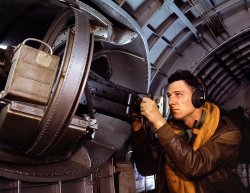
- Bathing Beauty: 1942
- ... the previous operation." 4x5 nitrate negative by Alfred Palmer for the Office of War Information. View full size.
Effable ... "staged" -- it's posed. - Dave]
(The Gallery, Alfred Palmer, Factories, WW2) ... Posted by Dave - 09/05/2012 - 7:10pm -
![Bathing Beauty: 1942 February 1942. Akron, Ohio. "Conversion. Beverage containers to aviation oxygen cylinders. Removal from solution tank at a rubber factory now producing metal essential for the Army. This bath, which follows the removal of the weld scale, gives the inside of the cylinder a further cleaning and removes all chemicals which may remain from the previous operation." 4x5 nitrate negative by Alfred Palmer for the Office of War Information. View full size.
EffablePrime Fark material here.
Tank McNamara Approves!Shorpy loves him some oxygen tanks!
https://www.shorpy.com/node/2403
https://www.shorpy.com/node/3245
https://www.shorpy.com/node/3737
https://www.shorpy.com/node/6187
https://www.shorpy.com/node/3831
Firestone Steel ProductsThere's a good chance that this photo was taken at the Firestone Steel Products Division in Akron. They also assembled Bofors wheel mounted cannons for the war.
Great lightingThe light that makes this shot is the one behind the man. See how it lights both the subject and the figure, both giving depth and mood. Brilliant. Staged though, obviously. Also look at the movement in the man's hands, you can see the rope through them.
[It's not "staged" -- it's posed. - Dave]
(The Gallery, Alfred Palmer, Factories, WW2)](https://www.shorpy.com/files/images/8e10966u.thumbnail.jpg)
- Fledglings: 1942
- ... View full size. 4x5 Kodachrome transparency by Alfred Palmer.
(The Gallery, Kodachromes, Alfred Palmer, Aviation, WW2) ... Posted by Dave - 09/05/2012 - 4:11pm -
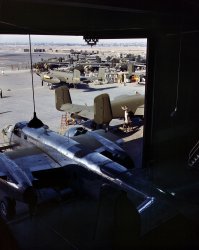
- A Cup of Fire: 1942
- ... View full size. 4x5 Kodachrome transparency by Alfred Palmer for the Office of War Information.
Captivating I don't know if ... Euclid Square Mall.
(The Gallery, Kodachromes, Alfred Palmer, WW2) ... Posted by Dave - 08/13/2012 - 3:57pm -
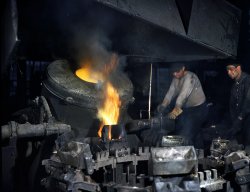
- First Flight: 1942
- ... View full size. 5x4 Kodachrome transparency by Alfred Palmer for the OWI.
Taking a Hard Look I love how the guard is looking ... in action" in 1943.
(The Gallery, Kodachromes, Alfred Palmer, Aviation, WW2) ... Posted by Dave - 08/04/2012 - 11:03pm -
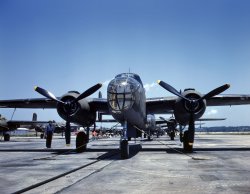
- Outta My Way: 1942
- ... -- Fort Knox, Kentucky." Kodachrome transparency by Alfred Palmer for the Office of War Information. View full size.
Creepy! ... head looking out.
(The Gallery, Kodachromes, Alfred Palmer, WW2) ... Posted by Dave - 06/07/2017 - 3:51pm -
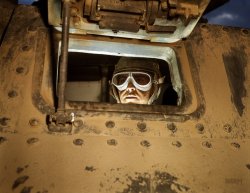
- Wingwoman: 1942
- ... View full size. 4x5 Kodachrome transparency by Alfred Palmer.
This reminds me so much of This reminds me so much of the ... the Riveter" poster.
(The Gallery, Kodachromes, Alfred Palmer, Aviation, WW2) ... Posted by Dave - 08/30/2012 - 12:02pm -
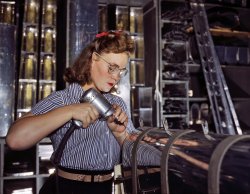
- Killing Machine: 1942
- ... View full size. 4x5 Kodachrome transparency by Alfred Palmer for the Office of War Information.
Tank Driver His face is so ... war until V-J Day
(The Gallery, Kodachromes, Alfred Palmer, WW2) ... Posted by Dave - 08/03/2012 - 3:22pm -
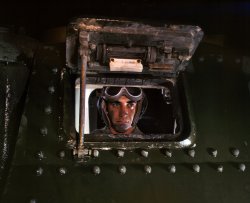
- Mobilized: December 1941
- ... Ohio." View full size. 4x5 nitrate negative by Alfred Palmer for the Office of War Information.
(The Gallery, Alfred Palmer, Cars, Trucks, Buses, Cleveland, WW2) ... Posted by Dave - 09/05/2012 - 4:11pm -
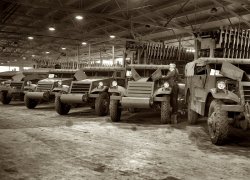
- Doing Her Part: 1942
- ... View full size. 4x5 Kodachrome transparency by Alfred Palmer.
I miss you Please, please, please, bring back my Kodachrome. I miss you dearly!
(The Gallery, Kodachromes, Alfred Palmer, Aviation, WW2) ... Posted by Dave - 08/10/2012 - 5:39pm -
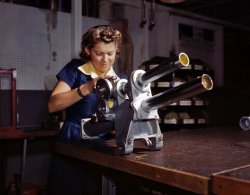
- A Swell Soiree: 1942
- ... View full size. Medium format negative by Alfred Palmer for the Office of War Information.
What names! French Vineyard ... photograph! Great picture.
(The Gallery, Alfred Palmer, Pittsburgh, WW2) ... Posted by Dave - 09/11/2011 - 11:19am -
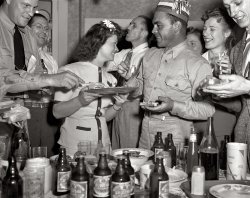
- Boilermaker: 1942
- ... boilers for a ship." 4x5 Kodachrome transparency by Alfred Palmer. View full size.
Combustion Engineering Sixty-six years later ... like that anymore.
(The Gallery, Kodachromes, Alfred Palmer, WW2) ... Posted by Dave - 08/10/2012 - 7:51pm -
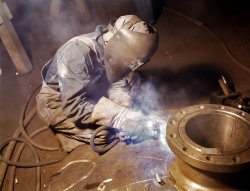
- Boston Harbor: 1906
- ... Indian. The three white 5-masted schooners are from the Palmer Fleet which carried coal between Hampton Roads, VA and the New England. ... Posted by Dave - 07/28/2012 - 4:38pm -
![Boston Harbor: 1906 Boston, Massachusetts, circa 1906. "Boston Harbor and waterfront." Panorama of two 8x10 inch glass negatives, Detroit Publishing Company. View full size.
The Waning Days of SailThe three ships with 5 masts each out in the harbor must be Cape Horners. Around the turn of the twentieth century, these enormous ships were constructed to be the fastest to Asia (before the Panama Canal), their speed outstripping even the storied "clipper ships."
Day-OThe smokestack with the diamond (left side of picture)is a United Fruit Company, now Chiquita Brands, "banana boat."
What's the island in the background?Pretty sure this was taken from Old Harbor South Boston making the samll island in the background Western Way or Thompson Island.
Incredible ChangeThere are very few things extant in this photo. The Custom House Block building is still there as is the three story building to its left. Yet beyond that it is near unrecognizable. The end of Long Wharf was the rented Boston Immigration Station now a open public pavillion. Central Wharf, which says Mellin's Food for Infants and Invalids is now home to the New England Aquarium.
The islands of the inner harbor can still be seen here. On the horizon from right to left there are many now lost landmarks. At the farthest right is Deer Island and the Suffolk County House of Correction which stood from 1880-1991). Next in the foreground is Governor's Island (with all those prominent trees) which was destroyed with Apple Island with the building of Logan International Airport. Apple is the thinnest mark almost lost in the masts of the white ships. The town of Winthrop is the rise above Apple with well built up Breed's Island to it's left. Part of Breed's became part of Logan and the rest were fused to East Boston.
Philadelphia SteaPhiladelphia Stea? (just to the left of the big black ship funnel in the left/center foreground):
Steaks
Steam
Steamers
Steamships
Steamship Company
Steamship Company Ltd.
BTW, who is piloting that rail barge a few yards from the dock in open water??
[Boston and] Philadelphia Stea[mship Line]Most likely "Philadelphia Steamship" or "Philadelphia Steamship Line," from the Boston and Philadelphia Steamship Company.
Agent: Francis P. Wing
Reference 1
Reference 2
Reference 3 (PDF)
Hard work and leisureFrom a European point of view, even big schooners were coasters rather than Cape Horners. The latter tended to be the domain of square-riggers (such as the Flying P-liners).
Anyway, those two pretty little steam yachts to the right make a nice contrast to the brawny cargo haulers.
Five-Masted Coal SchoonersBy 1900 few if any East Coast sailing ships were still engaged in the China Trade. Pacific Coast steamships and the Transcontinental Railroad had taken over most of that commerce as early as the 1870s. The great five-masted schooners seen here, all more than 300 feet in length, were mostly built in Maine beginning in the late 1890s to deliver coal to Boston and other East Coast ports. Some remained in service into the 1930s. Similar Pacific Coast schooners were used to deliver lumber. Here is a typical Maine schooner under sail, the "Martha P. Small," built in 1901. A brief history of five- and six-masted schooners.
Maritime CommerceIt was different in 1906. There's a barque being moved by a steam tug slightly left of center; you'd never see a commercial square rigger today. The large coasting schooners have all vanished long ago, too.
Even the steamships are classic, period pieces: the Metropolitan Steamship Company (right foreground) operated coastwise, overnight ferries to New York, leaving every day at 4 PM, according to the Wikipedia article. H. M Whitney, in center foreground, was one of its earlier ships, built in 1890 in Philadelphia and in spite of having been sunk in a collision and later raised, looks very smart in the photo. The two, near-sister twin funneled steamships moving down-channel in the center of the image are also handsome ships, lifeboats and davits very white considering their exposure to all that coal smoke. They too seem to be passenger ships.
We tend to forget that in 1906, roads were unpaved except in downtown areas, cars were slow and unreliable, and passenger air travel could barely be imagined. While trains were faster, coastwise travel by ship was more efficient and still very popular.
The group of schooner masts on the left look like fishing schooners; these continued working the Grand Banks up to World War II. There's a relatively modern looking steam ferry in that part of the photo also.
A great variety of maritime commerce, where today you would probably see just an occasional container ship or oil tanker. Coastwise trade in freight (but not passengers) still goes on, but it's mostly in barges pushed or towed by tugs, and Boston has lost ground to New York in international maritime trade.
Jib SailsI love the pic of the schooner from willc with five main sails and the jib sails on the bowsprit to match.
A marvelous photo so full ofA marvelous photo so full of detail.
The ship in the lower right corner identified by the name on her stern is the H.M Whitney. Built for the Metropolitan Steam Ship Company (Whose name can be seen on a flag and the M on the funnel) in 1890. She was sunk in Boston harbour in 1892 when run down by another steamer. Raised and restored, the H.M Whitney continued in M.S.S.Co service. She struck a rock in Hells Gate, N Y Harbour in fog in 1908 but did not sink. In WWI, the H.M. Whitney was sold for ocean service. She seems to have been renamed the Maria Pinango in 1923 and in 1928 sank while in tow near the Azores.
Quite a story.
I've seen this picture before...This panorama also appeared in the book "Portrait of a Port - Boston, 1852-1914" by W. H. Bunting (First Harvard University Press, 1971).
In the book Mr. Bunting identifies several of the ships: Steaming down channel is the Dominion Atlantic liner Prince George bound for Yarmouth, Nova Scotia. In the lower left hand corner is the Boston & Philadelphia steamer Indian. The three white 5-masted schooners are from the Palmer Fleet which carried coal between Hampton Roads, VA and the New England. In 1905 the fleet delivered 123 loads of coal to New England. They could make the round trip between Hampton Roads and Boston in about three weeks including loading time. Beyond the schooners is Governor's Island now part of Logan Airport.
The Metropolitan Line steamer H. M. Whitney ran to New York. She lies on the north side of India Wharf.
If anyone has any question about what else is in the picture post a note here and I'll see if I can answer it.
Crane shipAcross the harbor appears to be an old hulk built into a crane ship and listing to port.
(Panoramas, Boats & Bridges, Boston, DPC)](https://www.shorpy.com/files/images/SHORPY_Boston_Harbor_Panorama.thumbnail.jpg)
- War Machine: 1942
- ... View full size. 4x5 Kodachrome transparency by Alfred Palmer.
WWII Photos These Aircraft factory photos are great, I love ... shoe box. - Dave]
(The Gallery, Kodachromes, Alfred Palmer, Aviation, WW2) ... Posted by Dave - 07/22/2012 - 12:42pm -
![War Machine: 1942 October 1942. Cowling and control rods are added to motors for B-25 bombers as they move down the assembly line at North American Aviation, Inglewood, Calif. View full size. 4x5 Kodachrome transparency by Alfred Palmer.
WWII PhotosThese Aircraft factory photos are great, I love seeing them since I work in aviation.
[Well thanks. I think there may be a few more at the bottom of the shoe box. - Dave]
(The Gallery, Kodachromes, Alfred Palmer, Aviation, WW2)](https://www.shorpy.com/files/images/1a35304u.thumbnail.jpg)
- B-17 Betty: 1942
- ... View full size. 4x5 Kodachrome transparency by Alfred Palmer for the Office of War Information.
OWI Kodachromes Man, all these ... a gorgeous bonus.
(The Gallery, Kodachromes, Alfred Palmer, Aviation, WW2) ... Posted by Dave - 08/30/2012 - 3:28pm -
